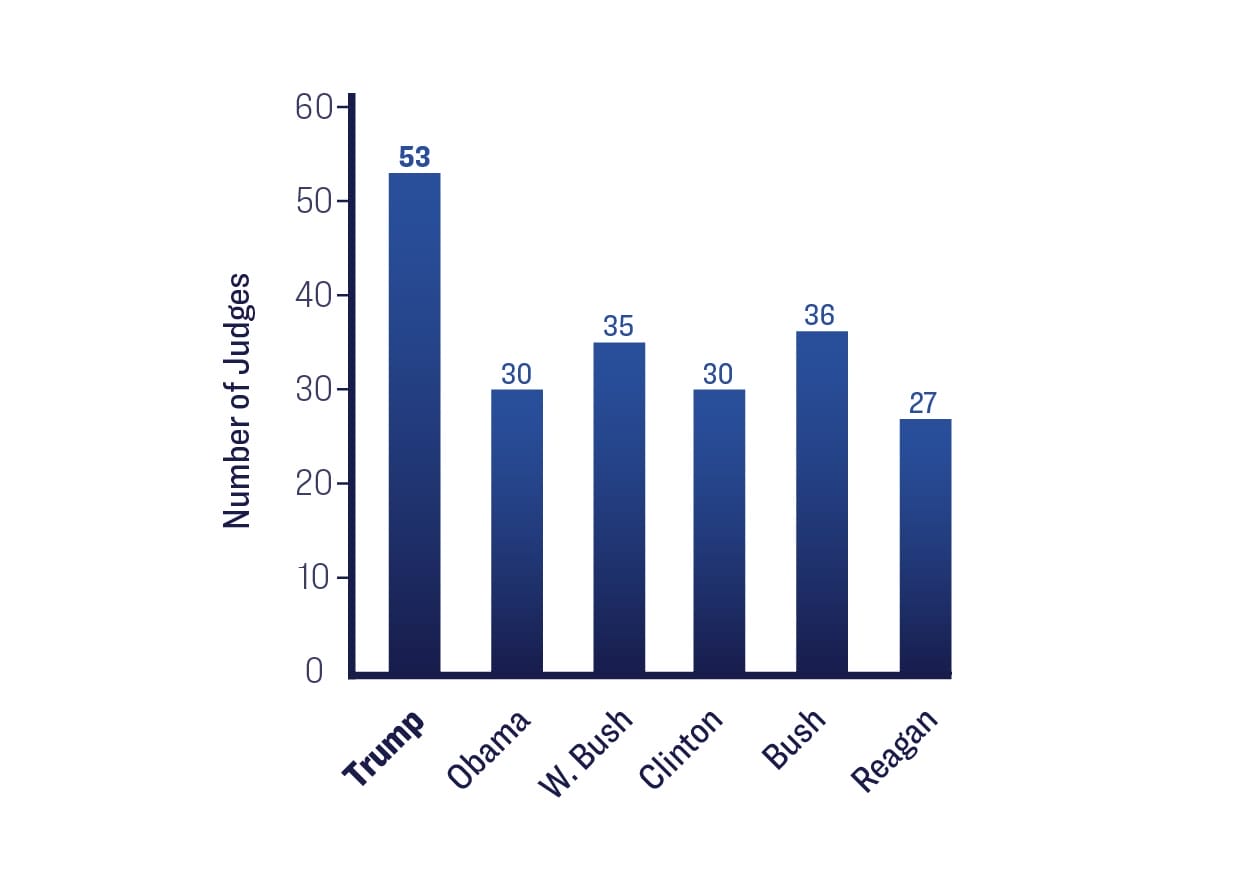NEW REPORT: Giffords Law Center Analyzes How Increasingly Extreme Judges Are Putting Gun Safety Laws in Jeopardy
‘Gun Safety Under Threat’ focuses on the future of the Second Amendment as President Trump rapidly fills federal court openings
August 17, 2020 — As President Trump continues to confirm judges to open seats at a rapid pace, Giffords Law Center’s new report, “Gun Safety Under Threat: How Extremist Judges are Undermining Gun Laws” examines how many of these new appointees pose a serious threat to the unprecedented progress states have made in passing gun violence prevention laws. The analysis exposes how the gun lobby, facing mounting legislative losses, has doubled down on litigation and is exerting its influence over who gets nominated to federal courts across the country.
“Courts are where the gun lobby is mounting its final, desperate attempt to cling to power and thwart lifesaving gun safety laws,” said Hannah Shearer, Litigation Director of Giffords Law Center. “As more and more Americans back stronger gun laws and lawmakers have realized gun safety is a winning issue, the gun lobby has shifted its focus to shaping the courts. Under President Trump, they are succeeding. Our report highlights how the gun lobby is trying to subvert the will of the people, and explains why anyone who cares about gun violence prevention needs to fight for our courts.”

On Friday, August 14, a Ninth Circuit panel ruled that California’s large-capacity magazine ban is unconstitutional, in a 2–1 decision written by a Trump-appointed judge. This decision makes the Ninth Circuit the first appellate court in the country to strike down a law like this, and further highlights the dangerous implications of the continuing nominations and confirmations of extremist justices.
Gun safety laws are older than the Second Amendment—in fact, according to the Duke Center for Firearms Law, over 100 gun laws were enacted between 1700 and 1790 alone. For years, the National Rifle Association (NRA) supported a wide range of gun safety laws, with NRA President Karl T. Frederick telling Congress in 1934 that he didn’t believe in “the general promiscuous toting of guns.” The gun lobby’s slide towards radicalism started in the 1970s, when its pivot to lobbying led to a concerted effort to fundamentally change how the Second Amendment is interpreted.
In recent decades, the NRA has spent millions to popularize and legitimize the notion of a sweeping individual right to bear arms. Its lawsuits and campaign culminated in the 2008 DC v. Heller ruling, which for the first time established an individual right to own handguns in the home for self-defense, while cautioning that the Second Amendment right was “not unlimited.”
While the Supreme Court rejected the position that most gun safety laws are unconstitutional, the gun lobby has continued to bring meritless suits, sometimes challenging the same law over and over. The $30 million that the NRA spent to elect President Trump paid off, as he has so far appointed 201 federal judges, including 53 judges to the US Courts of Appeals, outpacing appellate appointments by every president since Jimmy Carter.
These judges are ultimately responsible for deciding not only if many gun safety laws are constitutional, but also for determining the relevant legal framework for making this decision in the first place. Gun rights extremists have taken advantage, advancing radical legal theories of the Second Amendment in nationwide litigation offenses, seeking to undo legislative progress toward gun safety and prior court rulings upholding gun safety laws. This carries as high as the Supreme Court, where the confirmations of Justice Neil Gorsuch and Justice Brett Kavanaugh were viewed as victories by the gun lobby, which funded a marketing blitz in support of their nominations.
In spite of these efforts by the gun lobby, gun violence prevention advocates have made notable progress in the courts. Since the Heller ruling in 2008, a wide range of gun safety laws have been upheld by courts across the country, including:
- Restrictions on who can carry firearms in public.
- Location-based restrictions on the public carrying of firearms.
- Restrictions on firearm possession by children and teenagers, people with felony convictions, people with a history of mental illness, and people with demonstrable “extreme risk” factors.
- Restrictions on large-capacity magazines and assault weapons.
- Safety requirements for firearm design and sales.
- Fees on firearm purchases and waiting periods.
- Zoning, recordkeeping, and storage regulations for gun dealers and gun ranges.
- Background check requirements for firearm purchases.
As extremist judges demonstrate their willingness to ignore established jurisprudence, these victories are increasingly at risk. Voters who care about gun safety must look beyond a lawmaker’s legislative record to their voting record on judicial confirmations. It’s the best way to reflect their commitment—or lack thereof—to judges who respect constitutional history and the rule of law. Voters must insist on judicial nominees who respect the constitutionality of lifesaving gun regulations, and who will consider all of our rights to protect ourselves and our families from gun violence. Read the full report: “Gun Safety Under Threat: How Extremist Judges are Undermining Gun Laws.”